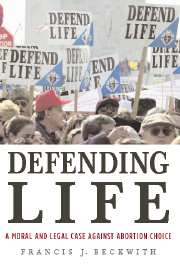Book contents
- Frontmatter
- Contents
- Acknowledgments
- Introduction
- PART I MORAL REASONING, LAW, AND POLITICS
- 1 Abortion and Moral Argument
- 2 The Supreme Court, Roe v. Wade, and Abortion Law
- 3 Abortion, Liberalism, and State Neutrality
- PART II ASSESSING THE CASE FOR ABORTION CHOICE AND AGAINST HUMAN INCLUSIVENESS
- PART III EXTENDING AND CONCLUDING THE ARGUMENT
- Notes
- Selected Bibliography
- Index
2 - The Supreme Court, Roe v. Wade, and Abortion Law
from PART I - MORAL REASONING, LAW, AND POLITICS
Published online by Cambridge University Press: 05 June 2012
- Frontmatter
- Contents
- Acknowledgments
- Introduction
- PART I MORAL REASONING, LAW, AND POLITICS
- 1 Abortion and Moral Argument
- 2 The Supreme Court, Roe v. Wade, and Abortion Law
- 3 Abortion, Liberalism, and State Neutrality
- PART II ASSESSING THE CASE FOR ABORTION CHOICE AND AGAINST HUMAN INCLUSIVENESS
- PART III EXTENDING AND CONCLUDING THE ARGUMENT
- Notes
- Selected Bibliography
- Index
Summary
No collection of U.S. Supreme Court opinions has been more misunderstood, and its arguments more misrepresented to the general public, than Roe v. Wade (1973) and its jurisprudential progeny.
To fully grasp the reasoning of Roe, its paucity as a piece of constitutional jurisprudence, and the current state of abortion law, we will look at three different but interrelated topics: (1) what the Court actually concluded in Roe; (2) the Court's reasoning in Roe; and (3) how subsequent Court opinions, including Casey v. Planned Parenthood (1992), have shaped the jurisprudence of abortion law.
WHAT THE COURT ACTUALLY CONCLUDED IN ROE
The case of Roe v. Wade (1973) concerned Jane Roe (a.k.a. Norman McCorvey), a resident of Texas, who claimed to have become pregnant as a result of a gang rape (which was found later to be a false charge years after the Court had issued its opinion). According to the Texas law at the time (essentially unchanged since 1856), a woman may procure an abortion only if it is necessary to save her life. Because Roe's pregnancy was not life threatening, she sued the state of Texas. In 1970, the unmarried Roe filed a class action suit in federal district court in Dallas. The federal court ruled that the Texas law was unconstitutionally vague and overbroad and infringed on a woman's right to reproductive freedom. The state of Texas appealed to the U.S. Supreme Court.
- Type
- Chapter
- Information
- Defending LifeA Moral and Legal Case against Abortion Choice, pp. 18 - 41Publisher: Cambridge University PressPrint publication year: 2007



